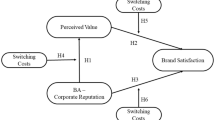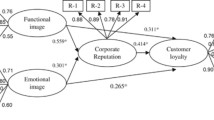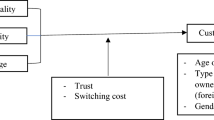Abstract
This study investigates how customer satisfaction and its instability affect the capital market reputation and shareholder returns. A sample from the American Customer Satisfaction Index database of 76 publicly traded firms, during the period from 2001 to 2007, was used to test the hypothesised model. The model consisted of a series of hypothesized relationships, where: (1) instability of customer satisfaction is negatively related to levels of customer satisfaction; (2) customer satisfaction is positively related to capital market reputation; and (3) capital market reputation is positively related to shareholder value. Structural equations modeling, using the partial least squares (PLS) algorithm, supported the hypotheses. The results are of importance and relevance to brand management and the emerging field of brand governance as they: explore the possible negative consequences of instability of customer satisfaction, develop theory on the relationship between customer satisfaction in product markets and capital market reputation and introduce a new measure of capital market reputation.

Similar content being viewed by others
References
Anderson, E. and Fornell, C. (2000) Foundations of the American Customer Satisfaction Index. Total Quality Management 11 (7): S869–S882.
Srinivasan, S. and Hanssens, D. (2009) Marketing and firm value: Metrics, methods, findings, and future directions. Journal of Marketing Research 46 (3): 293–312.
Gupta, S. and Zeithaml, V. (2006) Customer metrics and their impact on financial. Performance. Marketing Science 25 (6): 718–739.
Bowden, J. (2009) The process of customer engagement: A conceptual framework. Journal of Marketing Theory and Practice 17 (1): 63–74.
Szymanski, D. and Henard, D. (2001) Customer satisfaction: A meta-analysis. Journal of the Academy of Marketing Science 29 (1): 16–35.
Anderson, E., Fomell, C. and Mazvancheryl, S. (2004) Customer satisfaction and shareholder value. Journal of Marketing 68 (October): 172–185.
Aaker, D. (1991) Managing Brand Equity: Capitalizing on the Value of a Brand Name. New York: The Free Press.
Teece, D., Pisano, G. and Shuen, A. (1997) Dynamic capabilities and strategic management. Strategic Management Journal 18 (7): 509–533.
Payne, A. and Frow, P. (2005) A strategic framework for customer relationship management. Journal of Marketing 69 (October): 167–176.
Reinartz, W. and Kumar, V. (2000) On the profitability of long lifetime customers: An empirical investigation and implications for marketing. Journal of Marketing 64 (October): 17–35.
Reinartz, W., Thomas, J. and Kumar, V. (2005) Balancing acquisition and retention resources to maximize customer profitability. Journal of Marketing 69 (January): 63–79.
Rust, R., Lemon, K. and Zeithaml, V. (2004) Return on marketing: Using customer equity to focus marketing strategy. Journal of Marketing 68 (January): 109–127.
Gronroos, C. (1994) From marketing mix to relationship marketing: Towards a paradigm shift in marketing. Management Decision 32 (2): 4–20.
Reichheld, F.E. (1993) Loyalty-based Management. Harvard Business Review 71 (March–April): 64–73.
Anterasian, C., Graham, J. and Money, R.B. (1996) Are U.S. managers superstitious about market share? Sloan Management Review 37 (4): 67–77.
Anterasian, C. and Graham, J. (1989) When it's good management to sacrifice market share. Journal of Business Research 19 (3): 187–213.
Fornell, C., Mithas, S., Morgeson, F. and Krishnan, M. (2006) Customer satisfaction and stock price: High returns, low risk. Journal of Marketing 70 (1): 3–14.
PricewaterhouseCoopers. (2005) Trends 2005: Good Practices in Corporate Reporting. London: PWC.
Gupta, S., Lehmann, D. and Stuart, J. (2004) Valuing customers. Journal of Marketing Research 41 (February): 7–18.
Dierickx, I. and Cool, K. (1989) Asset stock accumulation and sustainability of competitive advantage. Management Science 35 (12): 1504–1511.
Rappaport, A. (2005) Perspectives: The economics of short-term performance obsession. Financial Analysts Journal 61 (3): 65–79.
Abrahamson, E. (2004) Avoiding repetitive change syndrome. Sloan Management Review 45 (2): 93–95.
De Meuse, K., Bergmann, T., Vanderheiden, P. and Roraff, C. (2004) New evidence regarding organizational downsizing and a firm's financial performance: A long-term analysis. Journal of Managerial Issues 16 (2): 155–177.
Bastien, D., Hostager, T. and Miles, H. (1996) Corporate Judo: Exploiting the dark side of a competitor's merger, acquisition, or downsizing. Journal of Management Inquiry 5 (3): 261–275.
Shah, P.P. (2000) Network destruction: The structural implications of downsizing. Academy of Management Journal 43 (1): 101–112.
Brown, S. and Eisenhardt, K. (1997) The art of continuous change: Linking complexity theory and time-paced evolution in relentlessly shifting organizations. Administrative Science Quarterly 42 (1): 1–34.
Fligstein, N. (2001) The Architecture of Markets: An Economic Sociology of Twenty-first-century Capitalist Societies. Princeton, NJ: Princeton University Press.
Upton, D. (1994) The management of manufacturing flexibility. California Management Review 36 (Winter): 72–89.
Hirchey, M. and Weygandt, J. (1985) Amortization policy for advertising and research and development expenditures. Journal of Accounting Research 23: 326–335.
Broadbent, S. (1993) Advertising effect. Journal of the Market Research Society 35: 37–49.
Peles, Y. (1971) Rates of amortization of advertising expenditures. Journal of Political Economy 79: 1032–1058.
Buck, S. (2001) The true cost of cutting ad spend: The impact on premium brand shares 1997-2001. Henley-on-Thames: World Advertising Research Center for The Advertising Association Economics Committee. http://www.warc.com/, accessed 20 October 2008.
Podolny, J. (1993) A Status-based model of market competition. American Journal of Sociology 98 (4): 829–872.
Aaker, D. and Jacobson, R. (1994) The financial information content of perceived quality. Journal of Marketing Research 31 (May): 191–201.
Thaler, R. (1993) Advances in Behavioral Finance. New York: Russell Sage Foundation.
Zuckerman, E. (1999) The categorical imperative: Securities analysts and the illegitimacy discount. American Journal of Sociology 104 (5): 1398–1438.
The Economist (2008) Finance and economics: Profits of doom; Buttonwood. 2 August; 388(8591): 72. In: Research Library Core [database on the Internet] [cited 9 December 2009], http://www.proquest.com/; Document ID: 1527174341.
Bhusan, R. (1989) Firm characteristics and analyst following. Journal of Accounting and Economics 11: 255–274.
Falk, R. and Miller, N. (1992) A Primer for Soft Modeling. Akron, OH: The University of Akron Press.
Fornell, C. and Larcker, D. (1981) Evaluating structural equation models with unobservable variables and measurement error. Journal of Marketing Research 18: 39–50.
Chin, W.W. and Newsted, P.R. (1999) Structural equation modeling analysis with small samples using partial least squares. In: R. Hoyle (ed.) Statistical Strategies for Small Sample Research. Thousand Oaks, CA: Sage, pp. 307–341.
Hulland, J. (1999) Use of partial least squares (PLS) in strategic management research: A review of four recent studies. Strategic Management Journal 20 (2): 195–204.
Minton, B. and Schrand, C. (1999) The impact of cash flow volatility on discretionary investment and the costs of debt and equity financing – An analysis of bond covenants. Journal of Financial Economics 54 (3): 423–460, (38).
Fama, E. and French, K. (1992) The cross-section of expected stock returns. Journal of Finance 47: 427–486.
Chin, W.W. (1998) The partial least squares approach for structural equation modeling. In: G.A. Marcoulides (ed.) Modern Methods for Business Research. London: Lawrence Erlbaum Associates, pp. 295–336.
Chin, W. (1998) Issues and opinion on structural equation modeling. MIS Quarterly 22 (March): vii–xvi.
Harris, R.J. (1985) A Primer on Multivariate Statistics. New York: Academic Press.
Fornell, C. (2007) ACSI Quarterly Commentaries Q2 2007, Manufacturing/Durable Goods E-Business, http://www.theacsi.org/index.php?option=com_content&task=view&id=172&Itemid=171, accessed 28 January 2009.
Chung, K. and Jo, H. (1996) The impact of security analyst's monitoring and marketing functions on the market value of firms. Journal of Financial and Quantitative Analysis 31 (4): 493–512.
Acknowledgements
Special thanks to John L. Graham, Ph.D., Professor Emeritus of the Merage Graduate School of Management at the University of California at Irvine, for inspiring this research and providing invaluable comments on earlier draughts of this manuscript, and to Shusheng Zhang, MBA, for his assistance with creating the dataset.
Author information
Authors and Affiliations
Rights and permissions
About this article
Cite this article
Kambara, K. Managing brand instability and capital market reputation: Implications for brand governance and marketing strategy. J Brand Manag 17, 568–578 (2010). https://doi.org/10.1057/bm.2010.21
Received:
Revised:
Published:
Issue Date:
DOI: https://doi.org/10.1057/bm.2010.21




